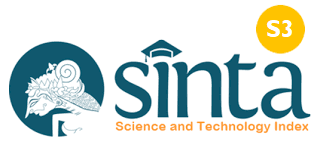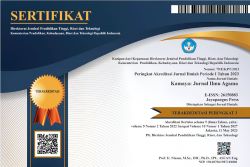Agama Hindu dan Budaya Bali: Warisan Luhur dalam Kehidupan Modern
DOI:
https://doi.org/10.37329/kamaya.v7i4.3805Keywords:
Culture, Religion, Society of BaliAbstract
Religion, previously regarded as a shared source of values and social norms, is now increasingly understood as a personal reconstruction process reflecting individual freedom in interpreting religious teachings. In Bali, this phenomenon is evident in the evolving practices of Balinese Hinduism, influenced by modernization and globalization. Nevertheless, the Balinese Hindu identity remains preserved by most of the community as an integral part of their culture. Balinese Hinduism plays a crucial role in maintaining social and cultural harmony through the implementation of panca yadnya rituals and the Tri Hita Karana principles, which emphasize balance in relationships between humans, God, and nature. This study aims to examine the dynamics of changes in Balinese Hindu practices and explore their role in maintaining social and cultural harmony amidst the challenges of globalization. The method employed is a literature review, analyzing relevant academic sources to develop theoretical contributions toward the preservation of Balinese Hindu culture and religion. The findings reveal that despite the increasing influence of modernization, local religious practices such as panca yadnya remain central to Balinese life. The tri hita karana principles continue to serve as a foundational framework supporting cultural sustainability and social harmony in the face of changing times. In conclusion, the Balinese Hindu identity demonstrates significant resilience through the integration of local traditions with modern challenges. This study highlights the importance of preserving Balinese Hindu religion and culture as a means of safeguarding social harmony and local wisdom in the era of globalization.
References
Ardana, I. G. G. (1982). Sejarah Perkembangan Hinduisme di Bali. Denpasar: PHDI
Artha, I. M. C., & Pitriani, N. R. V. (2024). The Existence of Hyang Waringin Temple in Kubu Customary Village:(Perspective of Hindu Religious Education). International Journal of Multidisciplinary Sciences, 2(3), 298-309.
Burman-Hall, L. (1996). Gamelan: The Traditional Music of Bali and Java. In Indonesian Performing Arts: An Introduction. Hawaii: University of Hawaii Press.
Dhana, I. G. M. K., Yuliani, N. M., Sariyani, N. N., Arlinayanti, K. D., & Hartaka, I. M. (2023). Nilai Ajaran Agama Hindu Dalam Upacara Ngaturang Idangan. Metta: Jurnal Ilmu Multidisiplin, 3(1), 37-54.
Dibia, I. W. (2014). Taksu Dalam Seni dan Kehidupan Bali. Denpasar: Bali Mangsi.
Fowler, J. W. (1995). Teori Perkembangan Kepercayaan. Yogyakarta: Kanisius.
Ghazali, A. M. (2011). Antropologi Agama: Upaya Memahami Keragaman Kepercayaan, Keyakinan, dan Agama. Bandung: Alfabeta.
Goris, R. (1974). Sekta Sekta di Bali. Denpasar: Bhratara.
Ihromi, T. O. (2006). Pokok-pokok antropologi budaya. Jakarta: Yayasan Obor Indonesia.
Koentjaraningrat. (1988). Manusia dan Kebudayaan di Indonesia. Jakarta: Djambatan.
Liliweri, A. (2005). Prasangka dan Konflik Komunikasi Lintas Budaya Masyarakat Multikultur. Yogyakarta: LKIS.
Mardawa, I. M. D., Sudarsana, I. K., & Mahardika, I. G. N. A. W. (2018). Penggunaan Banten daun di Pura Dadia Alangkajeng di Kelurahan Lelateng Kabupaten Jembrana (Kajian nilai pendidikan agama Hindu). Jurnal Penelitian Agama Hindu, 2(1), 47-51.
Maunati, Y. (2004). Identitas Budaya dan Politik Kebudayaan. Yogyakarta: LKiS.
Purnama, S. P. G. C. (2024). Peranan Pendidikan Agama Hindu Dalam Penguatan Karakter Di SMP Negeri 1 Bangli. Metta: Jurnal Ilmu Multidisiplin, 4(1), 156-167.
Putra, I. K. A. S. A., & Darmayanthi, E. (2023). The harmonization between humans and animals particularly the balinese dog race in Bali. International Journal of Multidisciplinary Sciences, 1(3), 301-314.
Sanjaya, I. B. P., & Budiadnya, P. (2024). Enhancement of Motivation to Learn Hinduism in Students of SMKN 1 Sukawati Gianyar. International Journal of Multidisciplinary Sciences, 2(3), 283-297.
Saputra, I. K. P., Sudarsana, I. K., & Mahardika, I. G. N. A. W. (2018). Tradisi Nunas Kecap Mandi di Pura Dalem Gede Desa Pakraman Galiran di Kabupaten Bangli (Perspektif Pendidikan Agama Hindu). Jurnal Penelitian Agama Hindu, 2(1), 13-18.
Soares, F., & Sudarsana, I. K. (2018). Religious Harmony Among Senior High School Students: Multicultural Education Case Study in the Cova-Lima District of East Timor. Vidyottama Sanatana: International Journal of Hindu Science and Religious Studies, 2(1), 154-162.
Subawa, I. M. P. (2018). Bali dalam Dinamika Masyarakat dan Kebudayaan di Tengah Perkembangan Pariwisata. Pariwisata Budaya: Jurnal Ilmiah Agama Dan Budaya, 3(1), 95-109.
Wartayasa, I. K. (2018). Kebudayaan Bali dan Agama Hindu. Ganaya: Jurnal Ilmu Sosial dan Humaniora, 1(2), 173-192.
Wiana, I. K. (2004). Bagaimana Umat Hindu Menghayati Tuhan. Jakarta: Pustaka Manikgeni.
Downloads
Published
How to Cite
Issue
Section
License
Copyright (c) 2024 Kamaya: Jurnal Ilmu Agama

This work is licensed under a Creative Commons Attribution-ShareAlike 4.0 International License.
An author who publishes in the Kamaya : Jurnal Ilmu Agama agrees to the following terms:
- Author retains the copyright and grants the journal the right of first publication of the work simultaneously licensed under the Creative Commons Attribution-ShareAlike 4.0 License that allows others to share the work with an acknowledgement of the work's authorship and initial publication in this journal
- Author is able to enter into separate, additional contractual arrangements for the non-exclusive distribution of the journal's published version of the work (e.g., post it to an institutional repository or publish it in a book) with the acknowledgement of its initial publication in this journal.
- Author is permitted and encouraged to post his/her work online (e.g., in institutional repositories or on their website) prior to and during the submission process, as it can lead to productive exchanges, as well as earlier and greater citation of the published work (See The Effect of Open Access).
Read more about the Creative Commons Attribution-ShareAlike 4.0 Licence here: https://creativecommons.org/licenses/by-sa/4.0/.





